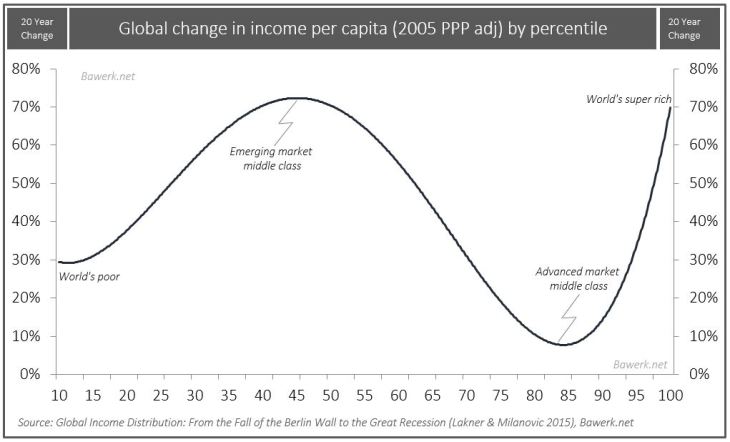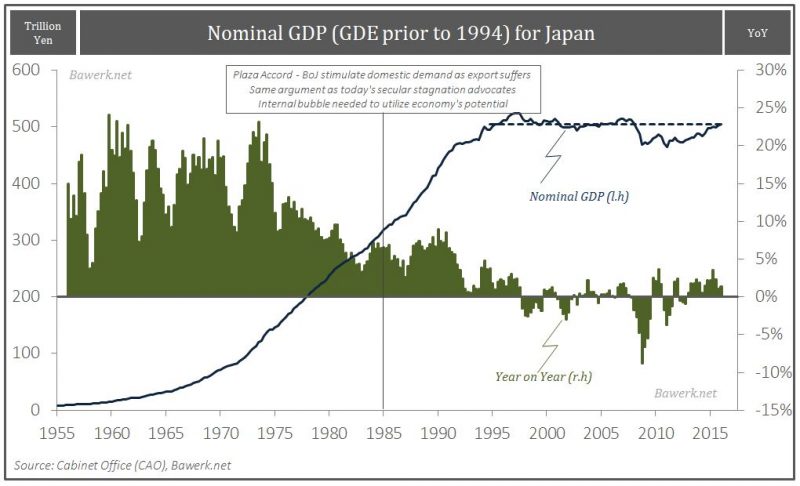Tag Archive: US
FX Weekly Preview: Shifting Portfolio Preferences Continue to Drive Capital Markets
Forces emanating from the US and Europe are driving the capital markets. The moves may be stretched technically, but the market adjustment has further to run as not even two Fed hikes are discounted for next year. European political concerns and an ECB expected to continue its asset purchases have driven German 2-year yields to new record lows.
Read More »
Read More »
Toward a New World Order, Part II
One of the most widespread misconceptions in the realm of politics is the notion of a left-right axis. This has been used over and over to explain political outcomes and paint the various factions as polar opposites. For example, in the US the two main parties, the Republicans (right) and Democrats (left), are often portrayed as a fight between good and evil.
Read More »
Read More »
Toward a New World Order?
A Brave New World is coming? Perhaps. We had a recent discussion with a group of people in the hopeless business of doing long term forecasting. This made us think about what the world will look like over the next 20 to 40 years. A pretty thankless task, but the bottom line is without a damn good war, Asia will be the way of the future.
Read More »
Read More »
US Jobs Data Maintains Fed Hike Expectations
US jobs data was largely in line or better than expected. The stronger earnings growth may be more important than the headline. Canada's data was mostly disappointing.
Read More »
Read More »
US Political Anxiety Stems Bond Sell-Off
Bond yields have been rising in the US and Europe since the summer. There are some country-specific considerations and some generalized factors. Anxiety over US politics has helped bonds recover some lost ground.
Read More »
Read More »
L’argent des banques centrales finit dans les paradis fiscaux!
Nous savions que la crise avait laminé les finances des Etats, de l’économie publique et des familles. Jusque là rien de nouveau. Mais en finance, quand quelqu’un perd, il y a en général quelqu’un d’autre qui gagne la même somme et peut-être plus. A moins qu’il ne s’agisse de billets physiques que l’on flambe, c’est comme ça.Nous allons donc nous intéresser aux grands gagnants de la crise financière.
Read More »
Read More »
USD ready for a second leg higher – then what?
One year ago we showed the following chart to explain the relative strong dollar that was on everyone’s mind at the time. With a second leg higher in the US dollar imminent, this particular chart will be more important than ever. Claims to dollars, such as demand and time deposits, or even more opaque money-like products created by the shadow banking system is just that, a claim or derivative on the final mean of payment, namely base money.
Read More »
Read More »
Do our money managers really believe this will end well?
An economic bubble is essentially an economic activity that cannot sustain itself without a continuous influx of new money and credit to bid away real resources from self-funding endeavors. Financial bubbles are obviously closely related as financial...
Read More »
Read More »
FX Weekly Preview: Politics to Overshadow Economics in the Week Ahead
The major central banks have placed down their markers and have moved to stage left. There are the late-month high frequency data, which pose some headline risks in the week ahead. The main focus for most investors will be on several political developments. The first US Presidential debate is wild card, in the sense that the outcome is unknown. In recent weeks, the polls have drawn close. In early August, Nate Silver’s fivethirtyeight.com, the gold...
Read More »
Read More »
The Road to Fascism in Just Two Charts
Laws of politics have been turned upside down. The Intellectuals Yet Idiots can make no sense of it. The underdog who ‘tell it how it is’ appeal to people while established reasoning does not.
Read More »
Read More »
Great Graphic: Median U.S. Income per Presidents
Median household income was higher in 2015 than in 2008, but still below 1999 peak in real terms. The bottom fifth of households by income have just recouped what was lost. Income growth did best under (Bill) Clinton and Reagan, including for top 5%. Origin of strong dollar policy means it will not be used as a trade weapon and it hasn't since Bentsen.
Read More »
Read More »
Labour Productivity, Taxes and Okun’s Law
The great “science” of economics once discovered an empirical relationship between GDP and unemployment that has been dubbed Okun’s Law. It simply states that the unemployment rate rises as GDP contracts, or vice versa, as production shrinks less peo...
Read More »
Read More »
Mission Creep – How the Fed will justify maintaining its excessive balance sheet
FOMC have changed their normalizing strategy several times and we now see the contours of yet another shift. The Federal Reserve was supposed to reduce its elevated balance sheet before moving interest higher as it would be impossible to increase the fed funds rate in the old fashioned way when the market was saturated with trillions of dollars in excess reserves.
Read More »
Read More »
Stupid is What Stupid Does – Secular Stagnation Redux
Which country, the United States or Japan, have had the fastest GDP growth rate since the financial crisis? Due to Japan’s bad reputation as a stagnant, debt ridden, central bank dependent, demographic basket case the question appears superfluous. The answer seemed so obvious to us that we haven’t really bothered looking into it until one day we started thinking about the demographic situation in the two countries.
Read More »
Read More »
The FOMC Butterfly that Will Ruin the World
Given the fact that the core CPI is currently over the arbitrarily set 2 per cent target unemployment below what the FOMC regards as full employment and GDP running at a rate far above the Federal Reserve’s own estimates of so-called potential; you would say the Federal Funds rate would be in the vicinity of five per cent.
Read More »
Read More »
Great Graphic: How the US Recovery Stacks Up
The US recovery may have surpassed the 2001 recovery in Q2. Though disappointing, the recovery has been faster than average from a balance sheet crisis. Although slow, it is hard to see the secular stagnation in the data.
Read More »
Read More »






















































